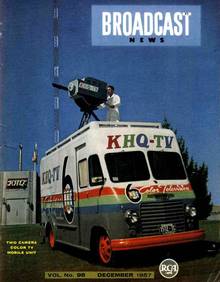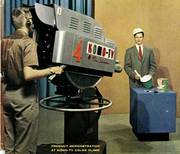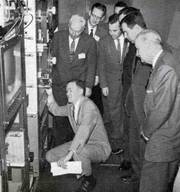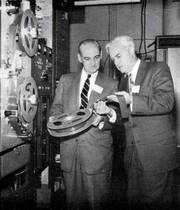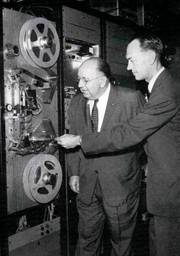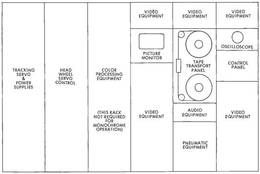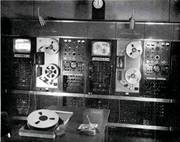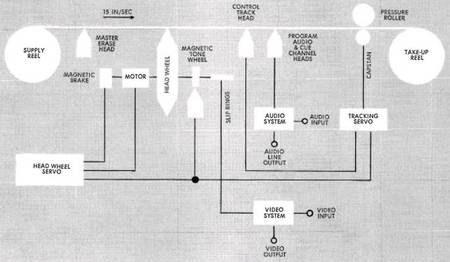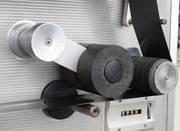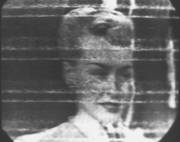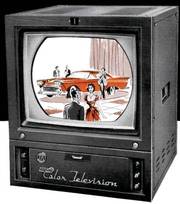RCA - "BROADCAST NEWS" -
Vol. No. 98 December 1957
published by RADIO CORPORATION OF AMERICA - BROADCAST & TELEVISION EQUIPMENT DIVISION, CAMDEN, NEW JERSEY. - Copyright 1957
Die erste Publikation des RCA 2" Quadruplex Videorecorders
Beim Rückblick auf die letzten 25 Jahrgänge der RCA "BROADCAST NEWS" sind öfter Promotion-Bilder des RCA-Chefs General Sarnoff mit der RCA eigenen Videorecorder- Entwicklung zu sehen. Auffällig auf diesen Fotos ist das dünne schmale Magnetband (vermutlich 1/4" Tonband) auf den sehr großen Alu-Spulen.
Nach dem April 1956 war damit aber schlagartig Schluß, denn Ampex hatte das Recorder-Rennen gegen alle anderen Wettbewerber gewonnen. Die (Publikations-) "Pause" bei RCA dauerte bis zum Dez. 1957, dieser Ausgabe hier der BROADCAST NEWS.
Jetzt steht der "neue" RCA Videorecorder an Stelle 1 in den News. Und obwohl gerade RCA der "Vorreiter" bei der Transistor-Entwicklung war, ist es ein riesiges komplettes Röhrengerät mit gewaltigen Ausmaßen.
Das spielte bei der Vorstellung erstmal keine Rolle - denn "wir" (bei RCA) haben jetzt auch "einen".
Das RCA Farbfernsehen mit den "Riesen- Farbkameras" ......
Die Farbfernsehtechnik wurde in den USA bereits seit 1950 mit verschiedensten Varianten propagiert und gesponsert. Die Firmen, - natürlich auch die RCA - brauchten neue Märkte. Bei uns hier in Deutschland gab es eine erste (Farb-) Fernseh- Ausstellung in 1950 in Berlin. Daß die allermeisten Amerikaner - selbst in den oberen Etagen - sich nicht vorstellen konnten, daß die Deutschen und auch die anderen Europäer 5 Jahre nach dem verheerenden Kriegsende ganz andere Sorgen hatten, als sich um Farbfernsehen zu kümmern, leuchtete den Ausstellern nur selten ein.
.
Das Inhaltsverzeichnis von Seite 3 (CONTENTS)
.
- COLOR VIDEO TAPE RECORDER ANNOUNCED BY RCA ... 6
- KHQ-TV COLORCASTS LILAC FESTIVAL......12
- HOW TO GET TOP PERFORMANCE
- FROM THE TP-6 TELEVISION FILM PROJECTOR . .26
- THE RCA TM-21-A STABILIZED COLOR MONITOR . .28
- THE ULTRAVIOLET COLOR-TRANSLATING
- TELEVISION MICROSCOPE.......42
- IMAGE ORBITERS EXTEND IMAGE ORTHICON LIFE . .46
- MOBILE COLOR CONTROL ROOM
- TO SERVE FOUR CROSLEY STATIONS......52
- I00-WATT TV TRANSMITTER........56
- BURMA PUTS POWERFUL NEW VOICE ON THE AIR . .60
- PLANNING A RADIO STATION-PART II......62
.
Es beginnt direkt auf Seite 6 - ganz vorne nach den Anzeigen :
COLOR VIDEO TAPE RECORDER ANNOUNCED BY RCA
NEW EQUIPMENT CAN HANDLE BOTH MONOCHROME AND COLOR FOR ALL BROADCAST AND CLOSED-CIRCUIT TV REQUIREMENTS
.
Introduction
Video tape recording equipment for both color and monochrome operation has been announced by the Broadcast and Television Equipment Department of RCA.
The color tape recorder was introduced in demonstrations to the trade press, television editors and broadcasters. In each case, reports were very favorable, the picture quality and color fidelity of the taped program very closely rivaling live presentations.
- Anmerkung : In 1957 waren die Amerikaner mit der Farbe im Fernsehen überhaupt nicht verwöhnt - wie später in 1967 die Deutschen. Das US-Farbfernsehen wurde bei uns nur als "Bunt-" Fernsehen mit allzu krassen Farben belächelt. Ende 1966 wurden die vier Orthicon Farbkameras der FESE wieder nach Darmstadt zurück geschickt, man solle dort erst mal seine Schularbeiten machen. Bereits das Studio-Farb-Bild sei ganz schlimm und so nicht akzeptabel - nämlich sehr oft deutlich verschwommen.
.
December 1957 - RCA Presentation - New York City
In New York City more than 30 representatives of the trade press and metropolitan newspapers viewed a special presentation in the RCA Exhibition Hall. The taped program originated in Camden and was sent via microwave to Philadelphia then via network cable to New York.
At its color studios in Burbank, California, NBC demonstrated to more than 100 television editors the kind of color pictures produced by the video tape recorder.
Excerpts from some of the network's major shows, which had been recorded in Camden, were fed via network lines to color receivers at Burbank for the demonstration.
Although these excerpts included portions of programs that originated in Burbank and thus traveled 6,000 miles (from Burbank to Camden and back again), color reproduction excited favorable reactions.
At this demonstration, Robert W. Sarnoff announced NBC's order for six pre-production equipments (wir ennen das Laborgeräte). Mr. Sarnoff said that video tape will open up a "new world for everyone concerned with network broadcasting."
.
Es wird noch ein Jahr dauern ...... mit dem TRT-1AC Recorder
Broadcasters who had the opportunity to visit Camden recently viewed a demonstration with considerable enthusiasm. Station VVBTV, Charlotte, North Carolina. has ordered the first pre-production model for use by a TV station.
Availability of the first production equipments is scheduled for December of 1958. Price on the color and monochrome equipment, Type TRT-1AC was announced at $63,000. The Type TRT-1A for monochrome only is priced at $49,500.
- Anmerkung : Natürlich kein Wort davon, daß Ampex aus Californien bereits liefern konnte, zwar mit einigem "Ruckeln", aber die Westcoast Ampexer hatten 2 Jahre Vorlauf. Auch kein Wort davon, daß die vergleichbare Ampex MAX deutlich teurer war, es sollen etwa 100.000 US Dollar gewesen sein. Weiterhin war die Ampex (Röhren-) MAZ deutlich kleiner als diese RCA (Röhren-) MAZ. All das hatte natürlich in einem Werbe-Artikel keinen Platz. Die amerikanische Presse für Funk und Fernsehen hatte aber den Vergleich angestellt. Diese Artikel kommen noch.
.
Tape Recorder Basics - 6 Racks fpr Color-Version
The RCA Video Tape Recorder provides a means of recording and playing back either color or monochrome video signals simultaneously with program sound. It will reproduce both video and audio signals with quality and fidelity that rival closely that of the original program material.
The entire color video tape recorder is contained in six standard cabinet racks. (See Fig. 5) Although designed specifically for color, it can handle monochrome as well as color. In addition, the equipment can be used for monochrome only operation simply by eliminating one rack, containing color processing equipment.
- Anmerkung : In den USA waren diese 19" Racks bereits Standard, als man in Deutschland noch versuchte, metrische Stahlschränke zu etablieren. Das ging später schief und auch wir hatten nur noch 19" Racks.
Conversely one could start with a monochrome system and advance to color at a later date.
.
Mindestens 3 Schränke im Control-Room
A minimum of three racks of equipment is required at the recording location. The tape transport mechanism with recording and playback heads, supply and take-up reels is vertically mounted in the center.
The local control panel, picture monitor and waveform display are located at eye level in the adjacent racks. Also included in the system is a remote control panel which permits handling of all basic operating functions from a remote location.
.
- Anmerkung : Es wird hier indirekt durch Weglassen beschrieben, daß 3 von den 6 Racks im Arbeitsraum (control room) aufgestellt werden müssten und 3 weitere Racks irgendwo im Backend "hinter den Kulissen".
.
How it Works
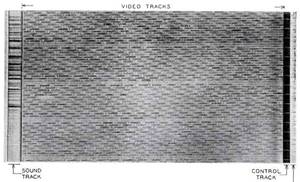
- FIG. 3. Sample audio and video tracks. They are produced by immersing a recorded sample of video lape in Visimag solution (a suspension of tiny iron particles in a highly volatile liquid). The iron particles cling to the magnetic areas, and once the fluid evaporates, the magnetic pattern becomes visible. The pattern shown here was picked off the video tape onto a strip of transparent adhesive tape, then photographed and engraved.
The RCA Video Tape Recorder records both audio and video signals on a single magnetic tape in the form of magnetic patterns. For playback these patterns are, in turn, scanned and processed to reproduce the original signals.
The magnetic patterns on the tape are comprised of "tracks" which are registered as the tape and magnetic recording heads move with respect to each other. The tracks containing picture information are transverse to the tape while the sound track is recorded along one edge. (See Fig. 3.)
Along the opposite edge of the tape art two narrow tracks, one for a control signal and the other for an audio cuing signal. The control signal is used in playback to assure that the magnetic heads properly trace the transverse recorded tracks.
The audio cuing signal is for the use of recording operators to relay special operative instructions for the information of personnel on playback.
.
A magnetic tape two inches wide und 64 Minutes program
The RCA Video Tape Recorder uses a magnetic tape two inches wide and 0.0015 inches thick. In operation, the tape speed is 15 inches per second (das waren ehemals unsere deutschen 38cm/s, das hate Ampex so übernomenund auf volle Inches aufgerundet). The signal representing one TV frame occupies 0.5 inches of tape length. A 64-minute supply of tape is contained on a standard NARTB 12 1/2-inch reel.
.
- Anmerkung : Ampex hatte anfänglich offensichtlich kleinere Spulen und spezifizierte nur 45 Minuten Laufzeit.
.
Recording Function
The sequence of functions which take place along the tape path are shown in Fig. 6. - Shortly after leaving the supply reel, the tape passes over a master erase head where all previous magnetization is erased.
It next passes by a high-speed, rotating wheel which contains four magnetic recording heads equally spaced about its periphery. The rotational axis of the wheel is parallel to the tape; thus, the recording heads slide across the tape in successive "swipes" leaving "transversely recorded" tracks.
The magnetic pattern recorded is a frequency modulated wave having a center frequency of approximately 5.5. megacycles. The instantaneous frequency is determined by the instantaneous amplitude of the input video signal.
The speed of the recording head wheel is held constant by a servo control which utilizes a reference signal derived from the station sync generator.
.
Das Synchron-Signal wird aufgezeichnet
Meanwhile, a short distance along the tape in the direction of the take-up reel, another recording head records a 240 CPS control signal on a longitudinal track along the edge of the tape nearest the tape transport panel.
The control signal frequency corresponds to the speed of rotation of the head wheel.
Still further along the tape path are located a group of audio magnetic heads for the program sound and cue channels. The cue track is recorded adjacent to the control track while the program sound is placed on a track along the opposite edge of the tape.
The first pair of heads are erase heads located near the edges of the tape to erase paths for the recording of program sound and cue. The next pair of heads are the program sound and cue channel record heads. A third sound head is provided for simultaneous playback to monitor the program sound channel during recording.
.
Der eigentliche Band-Antrieb - der "tape capstan"
Next along the path is the tape capstan which provides the prime moving force for the longitudinal motion of the tape. The tape is friction coupled to the capstan by means of a pressure roller.
During recording the capstan speed is stabilized by a method of control which utilizes a reference signal from the station sync generator. Once past the capstan, the tape passes over a tape guide and then is wound on the take-up reel.
.
Playback Function
After rewinding, the tape is ready for immediate playback. The tape path for playback is the same as described for recording. See Fig. 6.
However, since reproduction is essentially the inverse process of recording, various functions will differ. In playback, the erase heads are not energized. Protection against accidental erasure is provided by electrically interlocking the record and the playback control switches.
The control track signal is utilized to lock the motions of the high speed head wheel and the capstan in synchronism to assure tracking of the RF magnetic heads on the transverse recorded tracks. The program sound recording heads are utilized in playback to assure exact lip sync in the resulting program.
Each transverse recorded track contains the video signal for an average of 16.4 TV lines.
- Anmerkung : Hier wird - offensichtlich eine Ausnahme - von den sogenannten "TV lines" gesprochen, während die Amerikaner viel zu oft einfach nur "lines" spezifizierten. "TV lines" sind die echten physikalischen "Zeilen", bei uns sind es die 625 Zeilen, wobei der spätere VHS Recorder davon nur 240 "Linien" auflösen konnte.
.
Aus den 4 Bildteilen wird 1 Bild "gemacht"
The signals from the four heads on the rotating head wheel are fed by means of slip rings to four preamplifiers. An electronic switching system selects the successive groups of preamplifier output signals to reconstitute the recorded signal.
In the case of color operation, additional electronic processing of the color TV signal is accomplished to re-establish the sub-carrier burst to chrominance signal phase relationship that existed in the recorded color signal.
.
Fulfills Need
Those who have seen the RCA Color Video Tape Recorder in action have been very favorably impressed with the results.
Without doubt, this is the ideal means for handling the recording and reproduction of TV signals for both monochrome and color. It fills a long standing need of the television industry.
.
Editor's Note: For further information write to RCA, Broadcast Sales, Building 15-2. Camden, New Jersey. Copies of the printed literature illustrated on these pages are available and will be sent gratis.
Ein richtig großer Farbmonitor war eine Sensation
Natürlich gab es in den USA um 1958 bereits Farbfernseher - aber wie bei uns - legten die Broadcast-Profis andere Maßstäbe an und wollten im Studio die maximal mögliche Qualität ihrer Bilder betrachten.
.
Die genauen Einzelheiten der Technik in diesem Artikel sind nicht so interessant, aber die Menge der Texte, die sich der Autor aus den Fingern gezogen (gesogen) hatte, sind wirklich beeindruckend.
Und wir dürfen nicht übersehen, in den USA gab es bislang nur runde Farbbildröhren. Philips Valvo entwickelte bereits Rechteckröhren in Farbe und die Engländer waren auch dabei.
.


